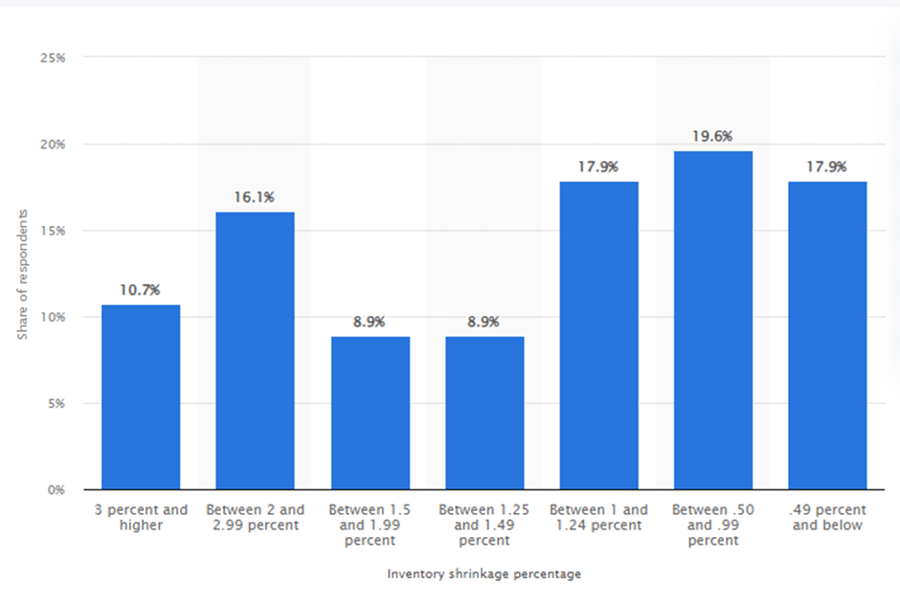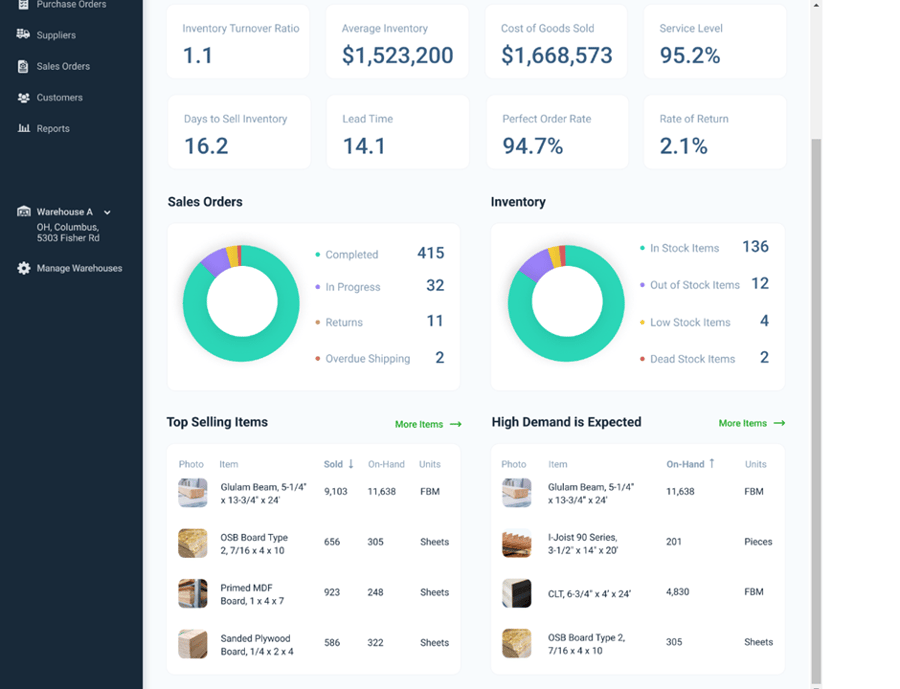
Inventory shrinkage is the bane of every retailer’s existence.
You work hard to source stock to sell, so when it disappears before you can sell it, that’s a problem. But it’s a problem that you need to address systematically. That’s because if you ignore it, it could get worse and begin to threaten your profitability.
This article explores why inventory shrinkage happens, how to calculate it, and what steps you can take to reduce it as much as possible.
How Does Inventory Shrinkage Happen?
No matter how conscientious you are about inventory accuracy, shrinkage is a fact of commercial life. Sometimes, stock goes missing — and you’re left scratching your head trying to figure out where it went.
There are several reasons it can happen:
- Shoplifting: This is the classic cause of a large proportion of all shrinkage in the retail sector. According to the National Retail Federation, it cost US retailers nearly $100 billion in 2021. While that’s a staggering figure and a real problem, shoplifting is obviously less of an issue if you only sell online.
- Employee Theft: All retail businesses have to watch out for this one. It’s not a pleasant thought, but some personnel can be less than loyal. The sad reality is that you may be confronted with the fact that someone you trusted is stealing from you.
- Supplier Dishonesty: It seems remarkable anyone would think they could get away with it in this day and age. But unscrupulous suppliers sometimes try to lowball the agreed consignment in the hope of skimming a few extra bucks on the deal.
- Administrative Error: Sometimes, shrinkage is due to more innocent mistakes. A simple data entry error could mean your inventory record logged an increase of 110 items when, in fact, you only received 100 from your supplier. That one slip would make it seem as if you’d lost ten items, even though they were never there in the first place.
- Damage: If you deal with fragile products, you’ll be painfully familiar with this one already. It’s common to write off a small percentage of items because they get damaged in transit.
- The Twilight Zone: Sometimes, it’s just a mystery. That said, the more vigilant you are about monitoring the other five reasons, the less likely your shrinkage will fall into this “unknown” category.
Distribution share of US retailers’ inventory shrinkage rate 2021

Source: Statista
The Business Impacts of Inventory Shrinkage
Keeping a close eye on shrinkage is an essential part of good inventory management. That’s because if it gets out of control, it can severely affect your business.
Lowered Sales Revenue Due to Product Losses
First and foremost, you can’t sell what you don’t have. If the quantity of missing products reaches a high enough level, it can become a real problem. It’ll put a dent in your sales revenue and could even begin to threaten your cash flow.
Smaller Stock Volumes Reduce Profit Margins
You pay to buy the stock you need and price it to sell at a level that makes you a profit. So, the more of it that goes missing, the tighter your profit margin is squeezed. In the worst-case scenario, you could even find your business running at a loss.
Replacing Lost Inventories Leads To Additional Costs
Of course, if a customer has bought something from you, they rightly expect it to arrive as promised. If your inventory records show that something is in stock when it isn’t, you face a stark choice. Do you disappoint the customer, who may not buy from you again? Or do you source a replacement item at further expense?
In the highly competitive retail sector, most operators will choose the latter to try to maintain customer loyalty. But again, that has an impact on the bottom line.
How To Calculate Inventory Shrinkage
To get to grips with the impact shrinkage is having on your business, you need to calculate it. That means implementing an accurate inventory accounting method so you know where you stand.
Establish the recorded or book inventory value.
The first step is to determine the official value of your inventory as recorded in the paperwork. Assuming you keep accurate records, this should be pretty straightforward. Simply take the total value of the stock you have at hand in the business.
To calculate shrinkage, use your cost price rather than the one you charge the customer. That’s because it’s a set price in the past, whereas the price you charge for individual items could change and is more of a notional value than a fixed one.
(If you make some items in-house, consider the labor cost.)
Conduct a physical inventory of items.
Now comes the hard work. You’re going to have to count all the items in stock individually. This might seem like an intimidating task if you carry a large number of items, but there’s no avoiding it.
Ideally, you should open each box of stock as it arrives from the supplier to verify the contents. If you do this, then doing a regular stock check will become more manageable.
Calculate the difference to get the shrinkage value.
Once you have the total value of all the stock you’re holding, you can do the math. In essence, this is about comparing what’s supposed to be there with what is actually there and working out the difference:
Shrinkage = total book value of inventory – total actual value of inventory
You can also express this in percentage terms. For example:
Shrinkage = $100,000 - $90,000 = $10,000
($10,000/$100,000) x 100 = 10%
This doesn’t tell you very much on its own because you have nothing to compare it to. But if you commit to calculating shrinkage regularly, you can monitor how it changes over time. Then, if you suddenly see a sharp uptick, you’ll know you need to investigate further.
Mitigating the Risks of Inventory Shrinkage
Maximizing your profit margin means minimizing shrinkage. It’s not just about responding to a sudden surge in shrinkage when you find one — it’s also about guarding against it in the first place.
Implement advanced security measures.
Shoring up your security is a great place to start. Installing surveillance cameras around the areas where you keep your stock is the first step. That way, you’ll have a record of events and be able to check for suspicious behavior if anything goes missing.
There’s plenty more you can do, though. Institute a policy of varying access levels and reinforce it with a key card system. The idea is that personnel should only have physical access to those parts of the building they need to for their role.
If you want to get serious, you could even hire security staff. However, take caution — adding more staff could add further complexity to the mix. So, if you are going to go down this route, make sure to thoroughly vet the employees you take on to fulfill this purpose.
Leverage inventory tech solutions.
While increasing security will help stop shrinkage caused by problematic behavior on site, it won’t address problems in the supply chain. For this, you need to consider high-tech solutions.
Use digital barcodes to track stock at every stage, from its origin to the final delivery point. Since these will be scanned at each step of the process, you’ll have a better idea of exactly where everything is at any given time. You can combine this with integrated payment solutions to create a rock-solid supply chain ecosystem where every item is monitored, and your invoicing is automatically reconciled.
If you handle large volumes of stock across multiple channels, it’s a good idea to invest in inventory management software. These tools help you track stock levels in real-time. They also come with top-tier analytics functionality that enables you to forecast demand.
You can also combine all of this with ERP systems to create a rock-solid supply chain ecosystem where every item is monitored. Your inventory data will seamlessly connect with your supply chain, customer, and accounting data, giving you a holistic overview of your business.

Source: ScienceSoft
Provide employee and staff training.
When it comes to tackling honest mistakes, training is critical. There are several issues you should cover here:
- Order Packing: Ensure the staff responsible for packaging orders double-checks the contents against the order list. Depending on the kind of items you sell, you may also need to provide training in proper handling and packing techniques to minimize breakages.
- Data Entry: All personnel who use your order management software should be trained in using it accurately to reduce errors in data entry.
- Supplier Delivery Handling: Ensure the staff who intake delivered orders check shipments for accuracy as soon as they arrive.
- Fraud Detection: Teach employees to recognize red flags associated with online fraudulent orders, like rush orders of high-value items to unfamiliar locations or multiple orders using different credit cards shipped to the same address.
Identify the root causes of shrinkage.
You can’t solve a problem you don’t understand. Tackling shrinkage in your business correctly means analyzing how it happens so you know what approach to take to address it.
If you have all the fundamentals covered, but you’re still seeing shrinkage, try to focus on the details. For instance, what if you find stock keeps disappearing from one specific area of the warehouse, but the surveillance cameras aren’t showing you anything useful?
In this case, you should conduct an on-site investigation. The problem could be something as simple as items falling behind a poorly fitted storage shelf into a space in the wall behind. Weirder things have happened.
Conduct regular audits.
The idea of taking time to conduct regular audits may seem tiresome. However, meticulous verification of every aspect of operations is standard practice in all kinds of businesses across the globe.
In the UK, software that simplifies accounting for self-employed professionals has become popular because it allows sole traders to photograph and scan all their receipts so they can track them automatically. While in Australia, the Australian Tax Office encourages companies to use cloud software to remain compliant with business regulations.
Similarly, carrying out regular inventory audits is vital for retailers. Your stock is the lifeblood of your business, so you must become familiar with how it ebbs and flows over time. How often you do it will depend on your circumstances, although most retailers should be looking at conducting a full inventory audit at least monthly.
Monitor supplier and vendor controls.
Reach out to your suppliers to establish what protections they have in place for the transfer of their stock. Make sure all contracts clearly define quality expectations and delivery timelines.
Establish clear protocols for receiving goods. This should include:
- Verification of quantities
- Inspection for quality
- Checking for damages or discrepancies
It’s good practice to implement a two-person check system. This is where two employees verify high-value or sensitive shipments to minimize errors.
You can even institute your own in-house rating system for suppliers. Create a scorecard based on their performance metrics such as on-time delivery, quality of goods, response time to issues, and adherence to contracts. That way, you can compare how reliable your suppliers are and choose the best.
Final Thoughts — Reducing Shrinkage for Good
You’ll never completely eliminate inventory shrinkage. Inevitably, some goods will get damaged in transit and have to be written off. That said, there’s a lot you can do to reduce the impact shrinkage has on your business.
With a few well-chosen tools and a strategic approach to planning, you can make sure as much of your stock as possible survives until it reaches the customer’s doorstep. And the result? One happy customer — who’ll hopefully return again and again.





Leave a reply or comment below